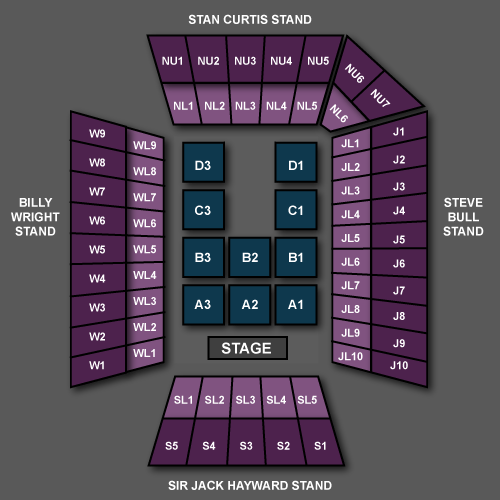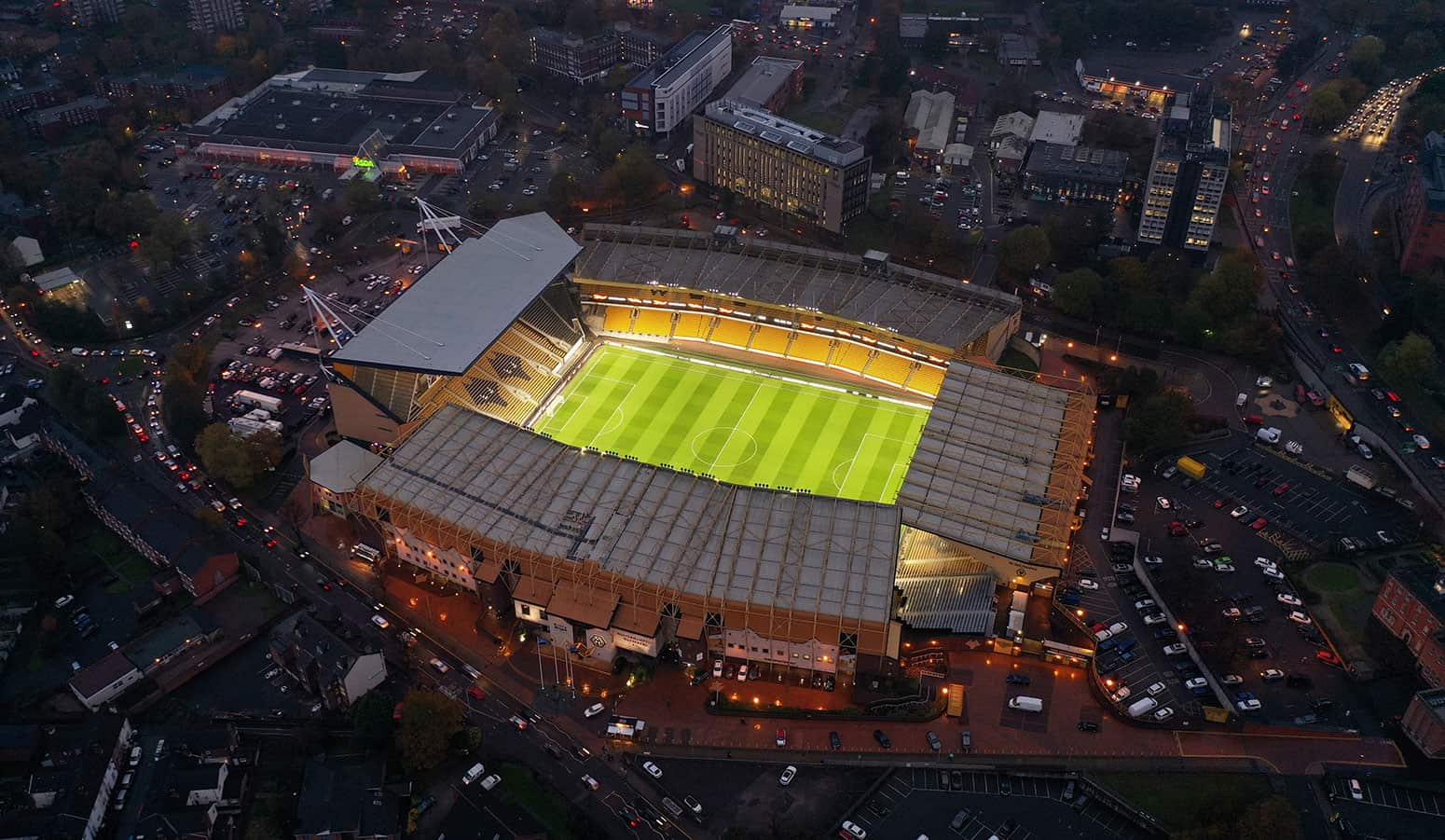Molineux Stadium is the home ground of Wolverhampton Wanderers Football Club, commonly known as Wolves. The stadium is located in the city of Wolverhampton, in the West Midlands region of England. It has a seating capacity of around 32,050 spectators.
The official home team color of the Wolverhampton Wanderers is old gold and black, it is usually call “The Wolves”
At the time of its multi-million dollar renovation in the early 1990s, Molineux was one of the largest and most modern stadiums in England, although it has since been dwarfed by other developments on the ground. The stadium has hosted England internationals and, more recently, England under-21 internationals, as well as the first UEFA Cup final in 1972.
Molineux is a 32,050-capacity stadium, but always drew much larger attendance when it was mostly standing. The attendance record is 61,315. Plans for a £40 million redevelopment program to rebuild and unite three sides of the stadium to increase capacity to 38,000 seats were announced in 2010. The first stage of this project, the Stan Cullis Stand, was completed in 2012. The next two stages were postponed as the club prioritized funding for youth academy development. There are tentative plans for a longer-term refurbishment of each stand that could create a capacity of 50,000.
| Built In: | 1889 |
| Capacity: | 32,050 |
| Home Teams: | Wolverhampton Wanderers |
| Ground Size: | (115 by 74 yd) |
Molineux Stadium History
Origins
The name Molineux originates from Benjamin Molineux, a prosperous local merchant (and distant relative of the now extinct Earls of Sefton) who, in 1744, bought land on which he built Molineux House (later the Molineux Hotel). and in which the stadium would eventually be built. The estate was purchased in 1860 by O.E. McGregor, who turned the land into a playground open to the public. The Molineux Grounds, as it was titled, included a wide range of facilities including an ice rink, cycle track, boating lake, and most importantly an area for football.
The grounds were sold to Northampton Brewery in 1889, who leased their use to Wolverhampton Wanderers, who had previously played at Dudley Road. After renovating the site, the first league match took place on 7 September 1889 in a 2–0 win over Notts County before a crowd of 4,000.
Wolves bought the freehold in 1923 for £5,607 (£303,338.70 at 2018 prices) and soon set about building a grandstand on the Waterloo Road side (designed by Archibald Leitch). In 1932 the club also built a new stand on the Molineux street side and went on to add a roof to the South Bank two years later. The stadium eventually now had four stands, which formed Molineux for the next half-century. The South Bank Stand terraces were one of the largest goal stands in Great Britain.
In 1953 the club became one of the first in Britain to install floodlights, at a cost of around £10,000 (£274,000 in 2018 prices). The first game illuminated took place on September 30, 1953, when the Wolves won 3-1 against South Africa. The referee for this match was Mr F Read of Willenhall. The addition of the floodlights opened the door for Molineux to host a series of midweek friendlies against teams from around the world. In the days before the formation of the European Cup and international club competitions, these games were highly prestigious and drew large crowds and interest, the BBC often televising such events. Later, in 1957, a new, taller set of floodlights was installed, at a cost of £25,000 (£595,000 in 2018 prices), as the stadium prepared to host its first European Cup games.
Further redevelopment and decline
In 1958, plans to redevelop Molineux into a 70,000-capacity stadium were unveiled in the early 1960s but were rejected by the local council and there were no major changes to the stadium for another 20 years.
The Molineux Street Stand (now for seating only) did not meet the standards of the Sports Grounds Safety Act 1975. The club set out to build a new stand behind the existing one, on land where homes had been demolished. The new stand, designed by the architects Atherden and Rutter, had a capacity of 9,348, equipped with 42 executive boxes, although sporting red seats in contrast to the club’s traditional colours. When construction was completed, the old stand in front was demolished, leaving the stand about 100 feet from the sideline. This new stand, called the John Ireland Stand (after the club’s then president), opened on 25 August 1979 at the start of a First Division match against Ipswich Town. This was intended as the first phase of a complete rebuild of the ground, which would have given it a capacity of 40,000 by 1984 and made it the first fully rebuilt stadium in post-war football league. However, the John Ireland stand was the only phase of this project that would come to fruition. The redevelopment was still a decade away.
In 1981, plans were unveiled for a further redevelopment of the stadium which would have cost over £4 million and involved futsal pitches, indoor and outdoor tennis courts and an eight-lane running track. However, they were soon scrapped due to mounting debts.
The John Ireland Stand (renamed The Steve Bull Stand in 2003), completed in 1979, cost £2.5 million (£13,675,000 at 2018 prices) and was one of the most expensive developments on any football ground in the UK . The cost of building the stand plunged Wolves deep into debt and the club narrowly avoided liquidation in 1982, when it was taken over by a group led by former player Derek Dougan.
When Wolves entered the Football League Fourth Division in 1986, the John Ireland Stand and South Bank terrace were the only sections of the ground in use, after new safety laws were put in place following the Bradford Stadium fire City force the closure of the North Bank and Waterloo Road Stand, which had fallen into disrepair. Additionally, attendances had dropped due to the club’s decline on the pitch.
The club’s perilous financial situation saw the stadium fall into ruin, with no funds either for repairs or to move the pitch. The club was saved from bankruptcy in August 1986 when Wolverhampton City Council bought the land for £1,120,000 (£3,236,800 in 2018 prices), along with the surrounding land, while Gallagher Estates, along with Asda Superstore chain, agreed to pay off outstanding debt: subject to the granting of building and planning permits for a hypermarket. Although the stadium continued in use, the disused sections were never reopened.
Present-day stadium
Sir Jack Hayward’s takeover of the club and stadium in 1990 paved the way for the redevelopment, which was further prompted by post-Taylor Report legislation banning terraces affecting Premier League and Division 5 stadiums. One from the 1993-1994 season. The North Bank terrace was demolished in October 1991 and the new Stan Cullis Stand was completed in August 1992, in time for the 1992–93 season. Then came the demolition of the Waterloo Road Stand, with the opening of the new Billy Wright Stand in August 1993. The final phase of redevelopment came in December 1993, when the new Jack Harris Stand opened on the site of the South Terrace. Bank.
The newly renovated stadium was officially inaugurated on December 7, 1993, in a friendly with Honvéd, the Hungarian team that had been defeated in one of Molineux’s most famous original illuminated friendlies.
In 2003 the John Ireland Stand has renamed the Steve Bull Stand (after the club’s record goalscorer) and at the same time, the southwest corner of the ground was filled with 900 temporary seats, known as the Graham Hughes Stand. , which, until its removal in the summer of 2006, brought Molineux’s capacity to 29,400. This seating area, now officially called the Wolves Community Trust Stand, was added back on the club’s return to the top flight in 2009, bringing the capacity to 29,195 before the club began redevelopment of the stadium in the summer of 2011. In August 2015, the Jack Harris Stand has renamed the Sir Jack Hayward Stand after Steve Morgan’s predecessor as a club owner, who had died earlier that year.
The stadium’s record attendance in its current configuration is 31,746, which was achieved against Liverpool on 23 January 2020 in the Premier League.
Stadium Capacity
Molineux Stadium has a seating capacity of 32,050.
Molineux Stadium Seating Plan

Notable Events & Records
Molineux Stadium has been the home of Wolverhampton Wanderers Football Club for over 130 years, and over that time, the club has set several records and achieved many milestones at the ground. Here are a few notable records associated with Molineux Stadium:
- Record Attendance: The record attendance at Molineux Stadium is 61,315, set on March 11, 1939, for a match between Wolverhampton Wanderers and Grimsby Town in the FA Cup Quarter-Final.
- Record League win: The club’s biggest victory at the Molineux Stadium in the league is 8-0, against Sunderland on March 6, 1954.
- Record Cup Win: The club’s biggest victory at the Molineux Stadium in the cup competition is 7-0, against AEL Limassol FC in the Europa League on the 9th of August 2019.
- European Honors: Wolverhampton Wanderers F.C. won European Cup (Today’s Champions League) in the 1957-58 season after winning against AC Milan.
- Domestic Honors: Wolverhampton Wanderers have won the First Division (Top tier) three times (1953–54, 1957–58, 1958–59), and they also have 4 FA Cup Trophies (1893, 1908, 1949, 1960).
Upcoming Events
Not Yet.
Parking
The new introduction improves the existing 400 street parking spaces that are free after 6:00 p.m. This brings the total number of free parking spaces to 550 in the city center.

